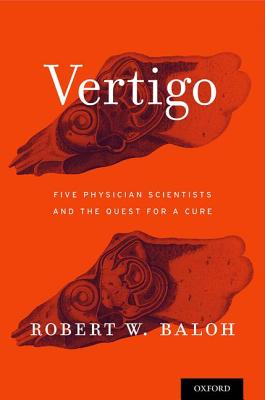图书简介
Vertigo: Five Physician Scientists and the Quest for a Cure follows this centuries long trek. The book follows the key discoveries made by Prosper Meniere (1799-1862) who first recognized that vertigo could originate from the inner ear, Josef Breuer (1842-1925) who conducted groundbreaking research on the inner ear during his evenings at home after he spent his days working in a busy private medical practice, Robert Barany (1876-1936) who received the Nobel Prize for his early work on the inner ear, Charles Hallpike (1900-1979) who showed that BPPV originates from the inner ear, and Harold Schuknecht (1917-1996) who provided key observations on the mechanism of BPPV.
Preface; Acknowledgments; Chapter 1. Introduction; The Inner Ear; Dizziness, Vertigo and the Inner Ear; What is Benign Paroxysmal Positional Vertigo (BPPV)?; So Who Discovered the Cure?; Section 1: Prosper Meniere (1799-1862); Chapter 2. Meniere recognizes that vertigo can originate from the inner ear; What was known about the inner ear in the mid 19th century?; First hint that the semicircular canals may be related to balance; Meniere presents his findings in 1861; The first recorded case of Meniere’s disease?; More evidence that vertigo can originate for the inner ear; Inconsistencies in Meniere’s description of the young girl with vertigo; Treatments for vertigo in mid 19th century; Meniere ’s comments trigger heated debate; Chapter 3. Meniere, a man of many interests; Meniere’s academic career; Meniere balances academic, patient and family activities; Meniere’s every day life; Meniere’s role in French society; Section 2: Josef Breuer (1842-1925); Chapter 4. Breuer discovers how the balance portion of the inner ear works; Eye movements and the semicircular canals; The gravity sensing otolith organs; Evolutionary development of the inner ear; Mach and his psychophysical experiments; Breuer and Mach work together to defend their theory; Crum-Brown, the model maker; Who contributed most to our current understanding of the vestibular system?; Chapter 5. Breuer, the Renaissance man; Upbringing and formative years; Breuer’s medical training; Breuer chooses private practice over academic medicine; Breuer, the family doctor; Chapter 6. Breuer’s experiments on the semicircular canals and otolith organs; Studies on the semicircular canals; Ewald’s laws; The Breuer-Von Cyon feud; Studies on the otolith organs; Overview of the inner ear sensory receptors; Chapter 7. Breuer’s contributions to psychiatry and philosophy; Freud’s early work in neuroanatomy; Anna O. and the beginnings of psychoanalysis; Breuer and Freud and Studies in Hysteria; The friendship between Breuer and Freud dissolves; Breuer’s philosophical beliefs; The final years; Section 3: Robert Barany (1876-1936); Chapter 8. Politzer’s otology clinic and the discovery of the caloric test; Politzer maneuver; Teaching in Politzer’s clinic; Robert Barany joins Politzer’s clinic; Barany discovers the caloric test; Chapter 9. Barany’s formative years and the conflict in Politzer’s clinic; Barany’s medical training; Source of conflict in Politzer’s clinic; Accusations against Barany; Chapter 10. The war years and Barany’s decision to leave Vienna; Barany receives the 1914 Nobel Prize in Medicine; Formal charges against Barany; Nobel committee response; Questions regarding Barany’s caloric theory; Chapter 11. Barany ’s test battery and the first description of BPPV; Romberg test; Pastpointing test; Barany’s syndrome; First description of benign paroxysmal positional vertigo (BPPV); Chapter 12. Barany ’s life in Uppsala and his work with Lorente de No; The brain and the neuronal theory; Lorente de No and Barany in Spain; Lorente de No works on central vestibular pathways with Barany; Barany’s final years; Section 4: Charles Hallpike (1900-1979); Chapter 13. Hallpike and the pathology of Meniere’s disease; Toynebee and early efforts to study pathology of the inner ear; Wittmaack and his new technique for preparing temporal bones; World-wide interest in Wittmaack’s technique; Hallpike and Cairns report on the pathology of Meniere ’s syndrome; Possible causes of Meniere’s syndrome; Yamakawa also describes the pathology of Meniere’s syndrome; Chapter 14. Hallpike’s formative years; The Indian connection; Early education and dealing with Legg-Perthes disease; Medical training; Personal life; Hallpike the inventor; Appointment at Queen Square; Hallpike’s colleagues at Queen Square; War years; Queen Square neurotology clinic; Chapter 15. Hallpike’s caloric test; Preparing the water; Hallpike’s caloric chart; Meaning of a Directional Preponderance; Importance of tonic signals originating from the inner ears; Controversy regarding the affect of cortical lesions; Chapter 16. Hallpike defines the syndrome of BPPV; Clinical features of BPPV; Confusion regarding the direction of the positional nystagmus; Strong evidence for an inner ear origin; Pathology of BPPV; Final years; Section 5: Harold Schuknecht (1917-1996); Chapter 17. Schuknecht and his breakthrough on BPPV; John Lindsay and University of Chicago otology clinic; Schuknecht begins his residency at the University of Chicago; Schuknecht’s formative years; Schuknecht becomes interested in BPPV; Search for the cause of BPPV; Schuknecht suggests a new mechanism for BPPV; Chapter 18. Schuknecht’s temporal bone bank in Boston; More temporal bone specimens from patients with BPPV; The cupulolithiasis theory; Schuknecht was not the first to propose the cupulolithiasis theory; A key question-which way does the cupula deviate?; How to explain the stereotypical nystagmus; Problems with the cupulolithiais theory; Chapter 19. Schuknecht’s crusade against myths in otology; Surgical treatments of Meniere’s disease; Viral neurolabyrinthitis; Questionable surgical procedures; The final years; Section 6: The pieces of the puzzle come together; Chapter 20. Semont and Epley maneuvers; Treatments based on the cupulolithiasis theory; Semont’s maneuver; Cupulolithiasis vs. canalithiasis; Epley ’s maneuver; Visualization of the free floating otolith debri; Chapter 21. Evolution of treatment maneuvers for BPPV; Epley’s maneuver; Semont’s maneuver; Features shared by the maneuvers; Variations on the theme; Horizontal canal BPPV; Chapter 22. Summary and Future Directions; Difficulties facing early investigators; Unanswered questions; Can patients do the maneuvers on their own?; Glossary
Trade Policy 买家须知
- 关于产品:
- ● 正版保障:本网站隶属于中国国际图书贸易集团公司,确保所有图书都是100%正版。
- ● 环保纸张:进口图书大多使用的都是环保轻型张,颜色偏黄,重量比较轻。
- ● 毛边版:即书翻页的地方,故意做成了参差不齐的样子,一般为精装版,更具收藏价值。
关于退换货:- 由于预订产品的特殊性,采购订单正式发订后,买方不得无故取消全部或部分产品的订购。
- 由于进口图书的特殊性,发生以下情况的,请直接拒收货物,由快递返回:
- ● 外包装破损/发错货/少发货/图书外观破损/图书配件不全(例如:光盘等)
并请在工作日通过电话400-008-1110联系我们。
- 签收后,如发生以下情况,请在签收后的5个工作日内联系客服办理退换货:
- ● 缺页/错页/错印/脱线
关于发货时间:- 一般情况下:
- ●【现货】 下单后48小时内由北京(库房)发出快递。
- ●【预订】【预售】下单后国外发货,到货时间预计5-8周左右,店铺默认中通快递,如需顺丰快递邮费到付。
- ● 需要开具发票的客户,发货时间可能在上述基础上再延后1-2个工作日(紧急发票需求,请联系010-68433105/3213);
- ● 如遇其他特殊原因,对发货时间有影响的,我们会第一时间在网站公告,敬请留意。
关于到货时间:- 由于进口图书入境入库后,都是委托第三方快递发货,所以我们只能保证在规定时间内发出,但无法为您保证确切的到货时间。
- ● 主要城市一般2-4天
- ● 偏远地区一般4-7天
关于接听咨询电话的时间:- 010-68433105/3213正常接听咨询电话的时间为:周一至周五上午8:30~下午5:00,周六、日及法定节假日休息,将无法接听来电,敬请谅解。
- 其它时间您也可以通过邮件联系我们:customer@readgo.cn,工作日会优先处理。
关于快递:- ● 已付款订单:主要由中通、宅急送负责派送,订单进度查询请拨打010-68433105/3213。
本书暂无推荐
本书暂无推荐















